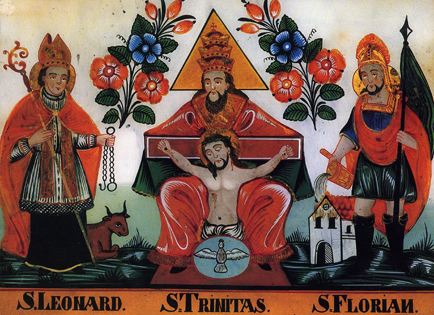
Reverse-glass painting is a technique whereby an image is essentially built up on a sheet of glass in reverse order: final details are painted first, background is added last, and the finished artwork is then viewed from its unpainted side. The process originated in sixteenth-century Germany, initially as a means for reproducing prints and other well-known religious images for display in upper-class homes. By the eighteenth century, reverse-glass paintings were produced and distributed on a wider scale. From Augsburg, the craft spread through the Black and Bavarian Forests, then to Silesia, Bohemia, and to the Austrian village of Sandl. There were nearly twenty workshops producing reverse-glass paintings in Sandl alone by the third quarter of the nineteenth century.
The skill and training of the artisans who did the actual painting varied. In Bohemia, the craft was a cottage industry, and often the different tasks were divided among entire families working at home. When reverse-glass painting initially made its way to Austria, professional painters accustomed to working in other media set to painting on glass. These artists’ lack of familiarity with the process yielded aesthetic imperfections, as well as, creative innovations. Prints, which could be easily copied through the glass, continued to provide a chief source of imagery. The technique favored a two-dimensional treatment of forms and space. Colors were applied in unshaded blocks, and contours were reduced to simple lines. Occasionally, a peasant motif such as a tulip was brushed in freehand.